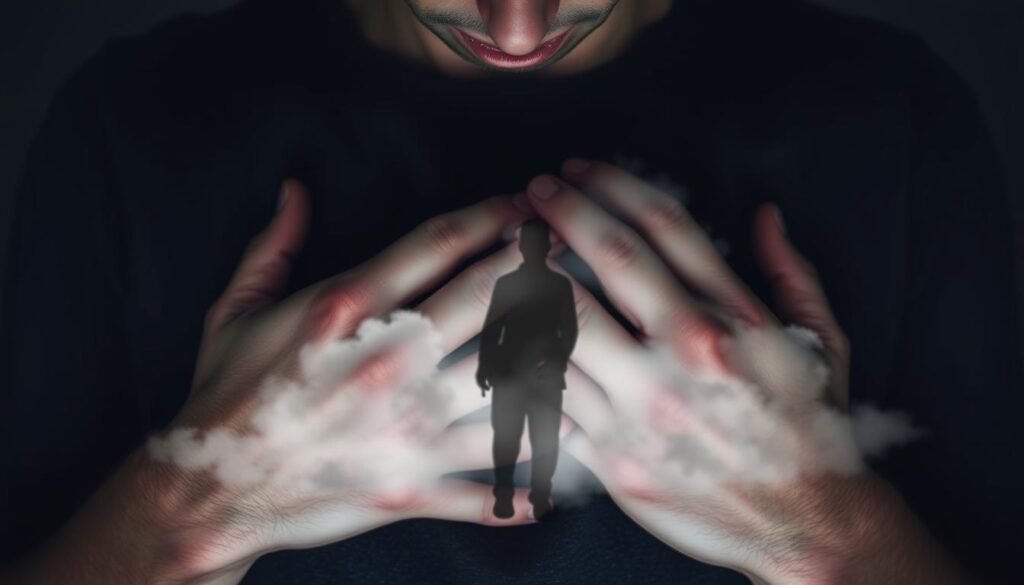Did you know about 5% of kids aged 6 months to 6 years have breath-holding spells? These spells can happen when a child feels strong emotions like anger or fear. It’s important for parents and caregivers to recognize the signs of breath holding anxiety. This knowledge can help them support and manage these situations. They’ll learn how to deal with the emotional and physical reactions of their child.
Key Takeaways
- Breath holding spells are prevalent in 5% of healthy children.
- The majority of occurrences happen in children aged 6 to 18 months.
- Episodes generally last less than a minute and can be triggered by strong emotions.
- Breath holding spells tend to run in families, suggesting a genetic link.
- Reassuring the child after a spell is essential to provide comfort and security.
- Severe cases may require immediate medical attention, especially if breathing issues persist.
Understanding Breath Holding Anxiety
Breath holding anxiety often starts with strong emotions like anger or fear in kids. Parents and caregivers might think it’s a serious health issue. But, these spells are usually not voluntary and tend to stop by themselves as kids grow up. By the age of six, most kids no longer have these issues.
This condition shows up with various signs, making things tough for everyone involved. Anxiety and trouble breathing feed off each other, making the fear worse. When anxiety grows, breathing gets harder. This makes the panic feel even bigger.
Understanding breath holding anxiety helps caregivers see what their child is going through. Realizing these episodes happen on their own means they can help without causing more stress. This knowledge is key in finding better ways to handle the situation. It leads to more effective strategies for dealing with anxiety and breathing troubles.
What Are Breath Holding Spells?
Breath holding spells are when a child stops breathing for a bit. This usually happens because of strong feelings. Kids under 18 months often do this. They might show signs like arching their back or getting stiff. It’s scary to see, but knowing about the two types—cyanotic and pallid—helps handle it better.
Cyanotic spells make a child’s face turn blue. This happens after they get really mad or frustrated. These are more common. Pallid spells make a child look pale. They happen after a sudden scare or pain. A kid might have these spells up to six times a week, sometimes more in one day.
Even if they seem serious, breath holding spells usually aren’t harmful. Most kids stop having them by the time they’re four to eight years old. Lots of healthy kids have these spells. About one in three of these kids have family members who had them too. Knowing this helps caregivers give the right support and care during these episodes.
Common Triggers for Breath Holding in Children
Knowing what triggers breath holding in children with anxiety helps parents and caregivers. Emotional upset is a big cause of these episodes. They often happen when a child feels angry, frustrated, or surprised.
For example, getting scolded might cause a child to hold their breath. This shows how emotional reactions are linked to these episodes.
Up to 5% of babies have breath-holding spells, usually before they turn 18 months old. By the time they’re six, these episodes tend to stop. But, it’s important to know what causes them.
Most breath-holding spells relate to emotional breathing changes. Pain or sudden emotional changes can also lead to breath holding. Stress during pregnancy and too much protectiveness may increase these episodes.
Boys are more likely to have breath-holding spells than girls. It’s key for adults to create a caring environment. Instead of punishing, they should offer support and understanding. This approach helps reduce the child’s anxiety and improves their emotional health.
| Trigger Type | Examples | Impacted Age Group |
|---|---|---|
| Emotional Distress | Anger, frustration, pain | 6 months – 6 years |
| Environmental Stressors | Reprimands, sudden injuries | 6 months – 6 years |
| Maternal Factors | Stress levels, overprotectiveness | Pre-pregnancy and during pregnancy |
Symptoms of Breath Holding Anxiety
When people, especially kids, have breath holding anxiety, it affects them physically and emotionally. Knowing what to look for helps caregivers act quickly. Being aware of the symptoms of breath holding anxiety means they can help reduce the stress and keep the person safe.
Physical Symptoms
Anxiety about breathing can show up in ways you can see. Some of these are:
- Changes in skin color, like turning blue or very pale
- Blacking out
- Body stiffening
- Hard time breathing, which may make the heart beat fast
Kids who can’t catch their breath might look really stressed. They suddenly can’t breathe right. This can be scary and needs quick action to keep them safe.
Emotional Symptoms
Feeling anxious can also affect how kids feel on the inside. They get more upset, especially if something bothers them like:
- Being disciplined
- Feeling uncomfortable
- Changes around them
This worry can mess with their daily life. It shows how our emotions and physical health are connected. Giving the right kind of help can soothe these hard feelings.
It’s important to deal with both the mind and body signs of anxiety. For more tips on anxiety and breathing, check out this helpful page.

| Symptom Type | Examples |
|---|---|
| Physical Symptoms | Cyanosis, loss of consciousness, muscle rigidity, shortness of breath |
| Emotional Symptoms | High anxiety, stress from discipline, being upset by environmental changes |
Types of Breath Holding Spells
Breath holding spells are a concern for many parents. They occur when kids experience specific episodes. There are two main types: cyanotic and pallid.
Cyanotic Breath Holding Spells
Cyanotic spells happen after kids feel very upset or mad. The child might cry hard and then stop breathing, turning blue. They usually feel better quickly, within a few moments.
These blue spells are common, making up about 85% of all cases.
Pallid Breath Holding Spells
Pallid spells often follow a small injury or scare. Unlike cyanotic spells, these make kids look very pale, and they might get stiff. Luckily, kids bounce back from these spells too, with no harm done.
These spells last between 1 to 2 minutes. It’s good to know they’re not dangerous, even though they can be scary.
| Type of Breath Holding Spell | Common Triggers | Skin Color Change | Recovery Time |
|---|---|---|---|
| Cyanotic Spells | Emotional responses (e.g., anger) | Turns blue | Rapid recovery |
| Pallid Spells | Mild injuries, fright | Turns pale | Rapid recovery |
The Connection Between Anxiety and Breathing Problems
Anxiety can lead to breathing problems in various ways. Shortness of breath is a common symptom. It affects both the body and mind of a person. Knowing how anxiety and breathing issues are linked shows how our feelings can change our health.
Anxiety Breathing Problems Explained
Research shows that people with anxiety may breathe differently. They might breathe too fast or feel like they can’t breathe well. This can make anxiety worse, leading to a hard-to-break cycle.
Genes might also play a role in how we breathe during anxiety attacks. Studies say some people might be more likely to feel breathless because of their genes. And being anxious a lot can increase stress. This makes breathing problems even worse.
Anxiety and breathing issues are connected by two main brain pathways. One pathway checks how we breathe. The other one affects how we feel about our breathing. High anxiety can mess up how we breathe. This can make us breathe shallowly or feel like we’re choking.
It’s important to recognize the signs of breathing problems caused by anxiety. Here are some helpful ways to manage them:
- Mindful breathing: Diaphragmatic breathing can make anxiety less intense and improve how we control our breath.
- Cognitive-behavioral therapy: This therapy helps change the thoughts that make us anxious about breathing.
- Grounding techniques: Being mindful can lower anxiety and help us breathe better.
- Regular exercise: Working out can reduce anxiety symptoms and make breathing steadier.
If anxiety-related breathing issues don’t get better, getting help is key. Healthcare professionals have treatments that help both the mental and physical sides of anxiety.

When to Seek Medical Attention
It’s important to know when to get help for anxiety breathing issues and breath holding spells. While breath holding spells usually aren’t serious, some signs need quick action. Caregivers need to watch for symptoms that hint at a bigger problem.
Signs That Require Immediate Care
Knowing when to seek urgent medical help is vital. Look out for:
- Prolonged breathing cessation beyond one minute.
- Initial breath holding spells in infants under six months.
- Excessive drowsiness or disorientation after a spell.
Stressful times might cause shortness of breath, leading to anxiety-related breathing issues. It’s crucial to understand these risks. If the symptoms seem serious, getting help is key for your health.
Consulting a Healthcare Professional
Talking to a healthcare professional is essential for dealing with anxiety breathing problems. A doctor can offer helpful advice and tests, like checking lung function and chest X-rays. Catching anxiety symptoms early helps avoid worse issues and find good ways to manage them. For more on spotting anxiety-related shortness of breath, check out trusted information.
Managing Anxiety Causing Breathing Difficulties
It’s key to handle anxiety well, especially when it makes breathing hard. There are many ways to create peace and better manage stress. Helpers are very important for kids to deal with their anxiety in good ways.
Stress triggers like money issues or a big loss can make anxiety worse. Knowing these triggers helps tackle them directly. Regular check-ins help caregivers spot stress in kids early, easing their concerns.
Deep breathing helps control anxiety well. This includes breathing in through the nose for six seconds, holding it, and exhaling slowly through the lips. Doing this around ten times can really ease anxiety. Using these techniques can fight breathing problems from anxiety and bring calmness.

Mindfulness helps manage emotions better. Things like meditation and yoga calm the body and mind. Focusing on slow breathing and relaxing muscles can lower anxiety and its effects. Sticking to these habits can help greatly with anxiety over time.
Dealing with anxiety doesn’t mean you’re on your own. Getting help from experts is key for severe anxiety. They can give personal advice for better results, making sure breathing issues are fixed quickly. Visit this link for more info on anxiety and how to get better: anxiety breathing problems.
| Management Strategies | Benefits |
|---|---|
| Deep Breathing Exercises | Reduces tension and promotes relaxation. |
| Mindfulness Practices | Enhances emotional regulation and reduces anxiety levels. |
| Professional Support | Offers tailored strategies and medical interventions. |
| Identifying Triggers | Prevents escalation of anxiety symptoms. |
| Regular Check-ins | Helps maintain open communication and emotional support. |
Using these methods helps people feel in control of their anxiety. Effective anxiety management means less breath holding and more positive lives.
Prevention Strategies for Breath Holding Episodes
It’s crucial to have prevention strategies for breath holding episodes in kids. Making changes that prevent these episodes can greatly help a child. It’s about making a space where kids feel safe and understood. Keeping a regular daily schedule and steering clear of too much stress helps. This can lower the anxiety that often causes kids to hold their breath.
Reducing Triggers
Lowering the risk involves recognizing what sets off these episodes and acting ahead of time. For caregivers, this can mean:
- Maintaining a calm and consistent daily routine.
- Avoiding overly stressful or demanding situations.
- Implementing gentle disciplinary methods that focus on understanding rather than punishment.
- Encouraging emotional awareness and expression to help children articulate their feelings.
Caregivers should know that even small upsets can lead to a breath-holding spell. Knowing and handling these triggers can make a child more emotionally strong.
Effective Coping Mechanisms
Providing kids with good ways to cope is key in managing breath holding episodes. These include:
- Teaching relaxation techniques such as deep breathing or counting to ten.
- Encouraging physical activity to help release pent-up energy and reduce anxiety.
- Collaborating with child psychologists for personalized coping strategies to build resilience to stress.
- Involving medical professionals when necessary to explore further supportive measures, particularly if breath holding occurs frequently.
Using these methods helps caregivers lessen triggers and gives kids tools to deal with stress. This can make breath holding spells happen less often. For more on managing these spells, check out the official resource.
| Strategy | Description | Benefits |
|---|---|---|
| Consistent Routine | Establishing set times for meals, play, and bedtime. | Reduces uncertainty and helps children feel secure. |
| Gentle Disciplinary Methods | Using positive reinforcement instead of punishment. | Encourages cooperative behavior without instilling fear. |
| Emotional Recognition | Teaching children to identify and express their emotions. | Promotes emotional intelligence and reduces anxiety. |
| Physical Activity | Incorporating regular physical play into their routine. | Reduces stress and enhances mood. |
Conclusion
Knowing the symptoms of breath holding anxiety is crucial for both caregivers and those who might struggle with it. If you understand breath holding spells, you can handle them better. This knowledge helps in taking steps to improve emotional and physical health.
It’s vital to get help when needed. Talking to healthcare experts and using effective strategies can lessen breath holding spells. This approach has been shown to help people manage their anxiety better, leading to a happier life.
Talking openly about anxiety helps build emotional strength. For many, seeking personalized treatments, like those at Montare Behavioral Health, is key to a better life. For more information, visit this resource.